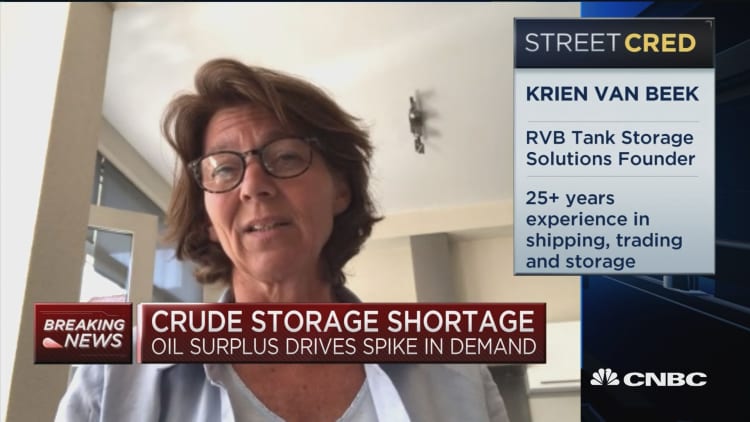The coronavirus crisis led to an unprecedented collapse in demand for oil and U.S. prices have rapidly fallen over the past week.
In order for the price to stabilize, U.S. producers have to further cut their production or be forced to curb it because they are out of places to store it. Energy analysts, looking at global oil storage by way of satellite data, say that while storage capacity is filling up, it's not near its limit yet.
Even though recent production cuts have been by "historic amounts," Ursa Space Systems analyst Geoffrey Craig explained that the cuts to supply are "a fraction of the decline in demand."
"The next catalyst will be inventories hitting capacity limits. The way you will know that is through satellite imagery, because the data isn't available outside of the U.S.," Craig told CNBC.

Ursa Space Systems, Kayrros and Orbital Insight are three analytics firms that specialize in applications for satellite data, especially for clients in the oil and gas industry. The firms make use of a variety of sources for data, ranging from European Space Agency's Sentinel-1 and Sentinel-5 satellites to imagery from commercial companies like Planet Labs or synthetic aperture radar (SAR) satellites. SAR is a type of imagery that can see at night, or even through cloud cover, to provide a constant view of an area from space.
"We're looking every week using satellite imagery at tanks all over the world," Craig said. "What we see in storage matches really well with what you see in seeing price action."
The difficulty and cost of storing crude oil at the U.S. hub in Cushing, Oklahoma was a major factor in the collapse of U.S. oil prices earlier this week. It caused the May contract for U.S. West Texas Intermediate (WTI) futures to tumble into negative territory for the first time ever on Monday.
"We're already at a price point where the signal to any operator globally is to shut down production," Kayrros market strategist Ted Hall told CNBC.
While U.S. oil production has begun to slow, falling to 12.2 million barrels a day last week from 13.1 million barrels a day a month ago, the cuts are not enough to match the lack of demand.
"In oil, we expect the market to test global storage capacity in the next 3-4 weeks (WTI was a local event), which will likely create substantial volatility with more spikes to the downside until supply finally equals demand, as with nowhere to store the oil, supply has no other option but to be shut-in down in-line with the expected demand losses," Goldman Sachs said in a note to investors on Friday.
There are about 3.2 billion barrels of crude oil already in global inventories, according to Orbital Insight, a record high. The majority of land-based oil storage is in the form of Floating Roof Tanks (FRT). Overall, Orbital Insight says the world's FRT storage is at 55.6% capacity, so the firm sees about 2 billion more barrels of storage capacity available.
Beyond FRT storage are alternatives, such as fixed roof tanks, salt caverns, or even more expensive floating storage like tankers at sea. Ursa said recent estimates put sea-based tanker storage at about 160 million barrels. Essentially, the lower price of oil drops, the more oil producers look to expensive types of storage capacity as viable. Storage capacity options have an inverse relationship to production methods, as more expensive methods of extracting oil become viable as the price rises.
"There's still places to put oil. It's been diminished because volumes have increased because of the amount that's been leased out. But they're going to keep searching out for more and more tanks to fill," Craig said.
"If this continues, there's going to be another phase where you would have to have another shift down in price," Craig added.
June contracts for WTI crude traded at $16.54 a barrel on Friday, down more than 9% this week. Brent crude traded at $21.22 a barrel, down more than 20% this week.
Hall noted that the recent panicked sell-off was largely focused on storage capacity running out in Cushing, Oklahoma. He pointed out that storage facilities in West Texas are below 50% capacity, with Europe and the Middle East each at 60% capacity as well.
"Throughout the rest of the U.S., in Canada and then across the rest of the world, there's still a lot of capacity out there for storage," Hall said. "Tanks are relatively full and have been filling, but there's still a lot of a lot of room to grow globally."
So long as major production cuts don't happen while capacity remains, the price of oil will remain tied significantly to how much storage is left.
"Based on what's gone on the past week, there's certainly a chance that we'll see more breakdowns based on really unique financial moments related to the financial contracts in crude," Hall added.
Subscribe to CNBC PRO for exclusive insights and analysis, and live business day programming from around the world.


